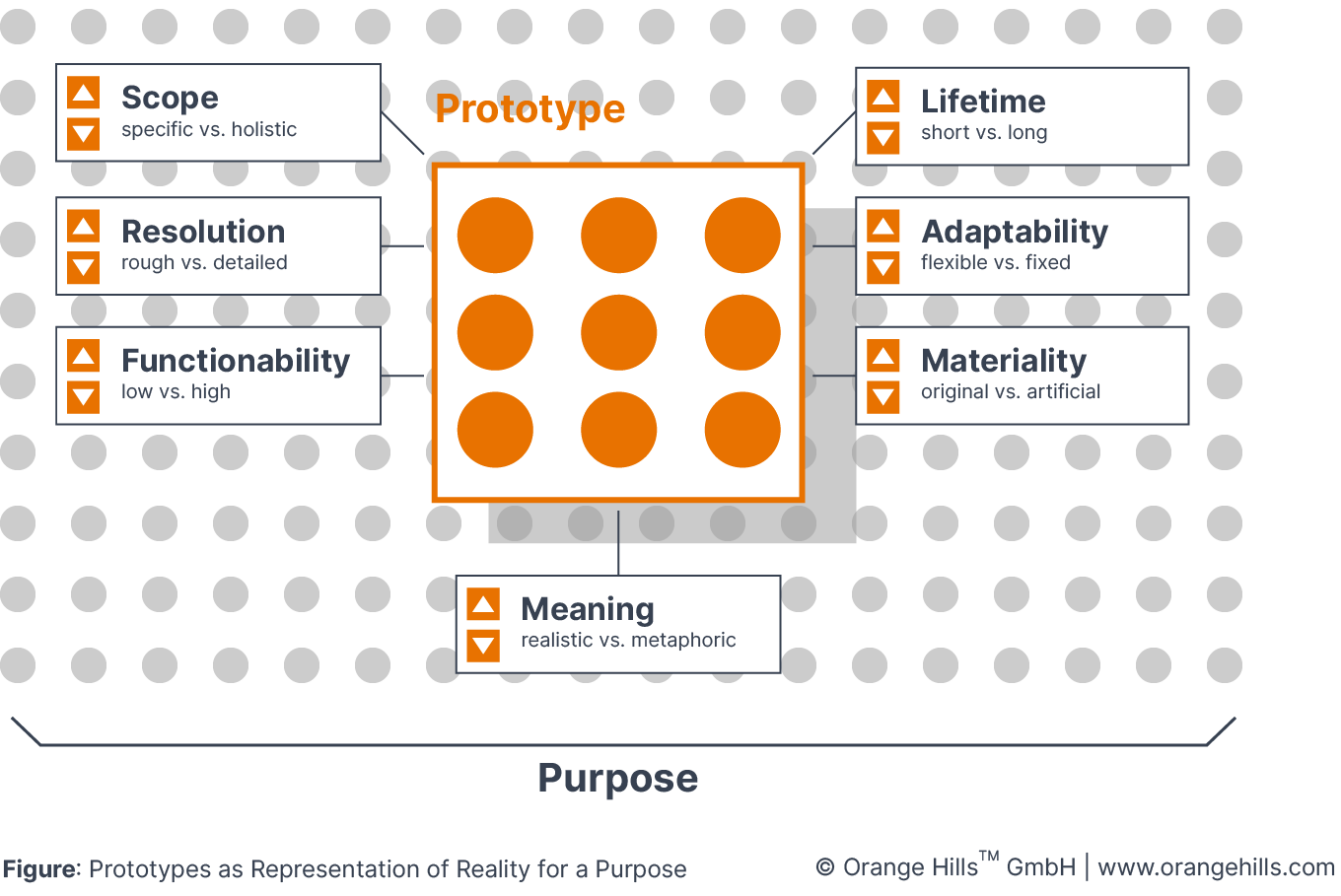Prototyping in Business Design
Welcome to the world of prototyping in Business Design. On this page I want to dive into what prototyping in Business Design actually is, why we need it and when we use it within our Business Design sprints. Prototyping is a powerful art, which has the power to create facts, change minds, spark ideas, inspire people and most importantly helps us to validate our most critical hypotheses in our business models. Honestly, I think it's that big. Let's dive right in.

Markus Sorg
Business Design Prototyper
Content
1. Introduction
Prototyping in Business Design is the process of building hardware, software and service prototypes to validate the most critical hypotheses and to explore open questions in our Business Models (see Hypotheses & Experiments for more details). But there is more. Prototyping has also a very important role within the Business Design team (socially and psychologically) and for interactions with stakeholders. It helps the team to think, to communicate (and convince), to inspire (themselves and others) and stay motivated. These human-related aspects of prototyping is often overlooked, but very important. Teams that prototype early and often show more performance because their thinking is more precise, they get more and better feedback, they come up with better conclusions and are generally more engaged and motivated. In Business Design, this is key, since we work with a lot of unknowns and complexity.
Let's dig a little bit deeper and look at the four main reasons to prototype in Business Design a bit more closely.
Exploration and Validation
Prototypes play a big role in the Validate Phase of the Business Design process. They are part of experiments to explore open questions and to validate the most critical hypotheses of our Business Models in a fact-based and data-driven way.
For example, you could build a click-dummy of your product to test the hypothesis that your tool reduces the time it takes to do XY by X%. Or you could build a landing page to test the hypothesis that Instagram is your sales channel where you find your customers (e.g. the conversion rate is X% higher than through other sales channels).
Precision in Thinking
Prototypes and the process of building a prototype helps the team create a common understanding of an idea or thought, show gaps in the understanding of team members and also helps teams find solutions for very specific problems.
For example, we build landing pages right after the Design Workshop. These prototypes help the team to think through different parts of their business model from the customer's perspective on a more concrete and detailed level. It also shows the team members where they have gaps in the understanding of their offerings and where they are still blurry in their thinking.
Communication (and Conviction)
Prototypes help the team to communicate their ideas and business models in a more visual, authentic and concrete way. This helps customers and stakeholders (internal and external) to get a better understanding of what the team is trying to achieve. This leads to much more and better feedback, which is important for us because we are working on something new and a lot of things are unclear. Better communication also may help us to convince our stakeholders because the vision of the team is much easier to understand.
For example, we often build prototypes for Sponsor Sneak Previews to communicate what the team is working on and what they are trying to achieve.
Inspiration and Motivation
The process of prototyping and prototypes itself are great ways to spark new insights and new ideas. While working on a particular solution, teams often generate ideas for better solutions based on their learnings with prototypes. Prototyping also help teams to stay motivated. They see fast, tangible progress, which gives teams the feeling that they are moving forward. It also gives teams the feeling that they can make it. This is key to stay motivated.
Besides the four main reasons to prototype in Business Design, there are actually a lot more. Prototyping helps us to..
...quickly disclose and address existing (and often necessary) conflicts within the team.
…create a sense of current status and urgency within the team.
...find out if the necessary skills to build the idea are present in the team.
2. Duration
5,5 weeks (see Validate Phase)
Keep in mind that more advanced prototypes require more than 5,5 weeks to build. Sometimes, prototyping activities span more than one iteration.
3. Key Activities
Before we start building a prototype we always go through the following steps:
Define the purpose: Ask yourself why you want to build a prototype. The answer to this question will define how you build prototype and what tools will help you build the prototype. If you have a questions regarding certain performance parameters of a new technology, you build a technical demonstrator that allows you to observe these parameters. If you need feedback from customers you may be better off wrapping your idea into a well designed sales brochure explaining the "magic moments" of your product in a simple language.
Set the attributes: Based on the purpose of the prototype, we define essential attributes of the prototypes, particularly the scope (see below), resolution, functionability, lifetime and flexibility. Depending on theses attributes, we pick a suitable prototyping tool to actually build the prototype. A physical form prototype, for instance, is often a visual representation of a product idea with a wide scope, low resolution, almost no functionability and medium flexibility, which means that you can't change the prototype that easy due to new requirements. A role play mapping a service process may have a different setting with a mode detailed resolution, functionability and flexibility.
Build the prototype: The purpose and attributes define the way we build the prototype with prototyping tools. We recommend to hire special Prototyping Engineers who are familiar with prototyping tools and the specific nature of Business Design Processes. They are able to build prototypes in a couple of hours - not days - and know what functions our components have to be part of the prototype and what can be left out. It is magic!
4. Prototyping vs. Engineering
Most people think that prototyping and engineering are very similar. But there are some major differences which are quite important to understand. First of all, prototyping has a completely different goal than engineering. Engineering is the process of building software or hardware at high quality, which is built to scale. Prototyping is the process of building software or hardware, which is built to quickly learn.
In prototyping, the approach, the process and decision-making is so much different than in engineering. In prototyping you have to make different trade-offs (regarding time, technology, performance, design), you need other skills (full-stack with design, frontend, backend, infrastructure etc.) and more of a business mind-set (not an engineering mindset).
5. Tools & Materials
6. Examples
Functional prototype (TRL 1-9*)
Form prototype
Mock-up
Ui screenshot
Click dummy
Video story
Storyboard
Role play
LEGO model (with metaphorical expression)
Process simulation
Template (e.g. Business Model)
P&L statement (not very visual but a representation of an idea)
Business plan
Sales brochure
*TRL = technology readiness level
Some examples may sound strange, but they are all in line with the definition above. They are just designed for different purposes in the Business Design process.
7. Attributes of Prototypes
Building the "right" prototype for a defined purpose is key in Business Design. There are not many frameworks out there that can guide us to define and describe prototypes. This is why we have put our heads together and fleshed out our own framework that offers a set of attributes describing a prototype as a visual representation of an idea (= original) in the context of Business Design:
Parameter | Description |
Scope | ...defines how many functions or components of an idea or concept is mapped into the prototype. We often describe the scope with "user stories". |
Resolution | ...defines how detailed the functions or components are mapped into the prototype. |
Functionability | ...defines whether the prototype will "work" the way it is intended. |
Adaptability | ...defines how quick and easy a prototype can be adapted to new insights and requirements. |
Materiality | ...defines whether we use the original material to build the prototype - or not. |
Lifetime | ...defines how long the prototype should be usable for the given purpose. |

By defining the purpose of a prototype and setting the attributes before you start building, this may help building the "right" prototype and not just something visual. This exercise also helps to pick a suitable prototyping tool for your Product, Software or Service / Process Prototype. Try it out! It will save you time and money!
8. Instructions for Coaches
Always ask the "Why?" (= purpose) question first, before you start building something. Without a clear purpose prototyping is waste of time!
Keep in mind that prototyping can unleash many fears: A prototype is a brutally honest and transparent representation of developed ideas and uncovers ruthlessly strengths and weaknesses of the idea and the project team.
Building a prototype is often part of the preparation for first customer feedback. The same here: Be aware that feedback is not always appreciated by all stakeholders in the project. It may be considered as perilous, since some answers might uncover things that has been protected by them.
Teams tend to build too much. Make sure that the team builds only what they need to test their hypotheses. Not more!
Building a prototype is only half of the work. To learn the right things we need to measure. That's why we need to collect the right data with our prototype. Make sure, the team does that.
It's often the case that the team forgets that they are building a prototype. Make sure that they are aware that they don't build the final product. For most of the questions we need to get answered, we don't need too much details within the prototype
